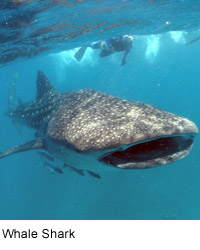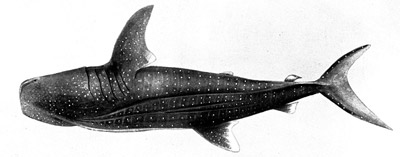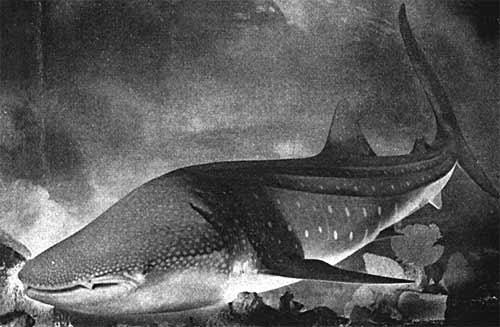|

Record Holder: The greatest size accurately recorded was 12 meters (39 ft) long,
with unofficial accounts of 18 meters (59 ft). It is not to be confused
with the Basking shark (Cetorhinus maximus), the second largest
fish.
 Big Mouth: A member of the order Orectolobiformes,
it is a filter feeder. The shark has a capacious mouth which can
be up to 1.5m (5 ft) wide and contain up to 300 rows of tiny teeth. Big Mouth: A member of the order Orectolobiformes,
it is a filter feeder. The shark has a capacious mouth which can
be up to 1.5m (5 ft) wide and contain up to 300 rows of tiny teeth.
Flat Head: As part of its feeding process, it also has five large pairs of
gill arches. Two small eyes are located towards the front of the
shark's wide, flat head.
The body is mostly grey with a white belly;
three prominent ridges run along each side of the animal and the
skin is marked with a 'checkerboard' of pale yellow spots and stripes.
These spots are unique with every whale shark. Because of the spots
uniqueness they can be used to mark each animal and make an accurate
population count. But so far the whale sharks have not been fully
and accurately counted. Its skin can be up to 10 cm thick.
Slow Swimmer: The shark has two pairs each of dorsal
fins and pectoral fins. A juvenile whale shark's tail has a greater
top fin than lower fin while the adult tail becomes semi-lunate,
or crescent-shaped. The shark's spiracles are just behind the eyes.
The whale shark is not an efficient swimmer; the entire body is
in motion while the animal swims. The result of this motion, one
that is very unusual for sharks, is an average speed of around 5
km/h.


On the Menu: The whale shark feeds on phytoplankton, macro-algae, plankton, krill
or nektonic life (small squid or vertebrates). The many rows of
teeth play no role in feeding, instead, water is actively drawn
into the mouth and is passed over gill rakers and then out through
the gill arches. Any material caught in the rakers is swallowed.
The sharks, however, are active feeders and target concentrations
of plankton or fish by olfactory cues rather than simply 'vacuuming'
constantly. According to sailors, whale sharks congregate at reefs
off the Belizean Caribbean coast, supplementing their ordinary diet
by feeding on the roe of giant cubera snappers, which spawn in these
waters in May, June and July, and between the full and quarter moons
of these months.
Gentle Shark: When it is explained that most sharks are not dangerous to humans,
this species is used as the leading example. Divers and snorkelers
can swim around the giant fish without any problems.
Where in the World: The shark is often seen in Thailand, the Maldives, the Red Sea,
Western Australia (Ningaloo reef), Gladden Spit Marine Reserve in
Belize, and at the Galapagos islands. They are regularly seen from
December to May in the Philippines (Donsol). Lucky divers have also
come across whale sharks in the Seychelles and in Puerto Rico. Between
December and September, they are well known to swim along the bay
of La Paz in the mexican Baja California.

Birds and Bees: Like most sharks, the reproductive habits of the whale shark are
obscure. Based on the study of a single egg recovered off the coast
of Mexico in 1956, it was believed to be oviparous, but the capture
of a pregnant female in July 1996 containing 300 young whale sharks
indicates that they are viviparous with ovoviviparous development.
The eggs remain in the body and the females give birth to live 40
to 60 cm young. It is believed that they reach sexual maturity at
around 30 years and the life span has been estimated to be between
60 and 150 years.

All text is available under the terms
of the GNU Free Documentation License
|